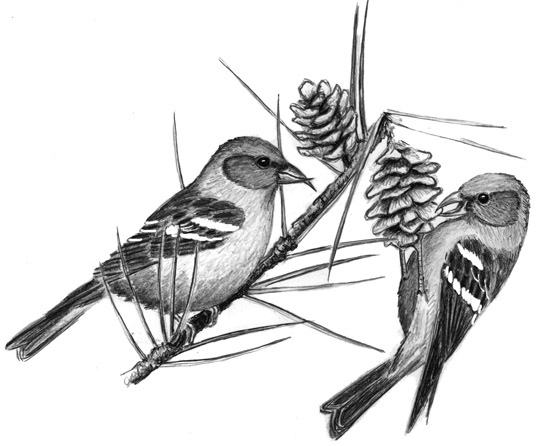
Dear Bird Folks,
I took the enclosed picture of a bird at my feeder. It’s a new bird for me and I can’t quite figure out what kind of bird it is. Can you help me?
-Linda, Eastham, MA
You know Linda,
There’s a special place in heaven for people like you. I’m talking about people who tell me about an unusual bird that they’ve seen and have photographic images to back it up. A picture makes things so much easier. Bird identification is tough enough, but trying to figure out a bird from someone’s vague verbal description is nearly impossible. Especially if that person has a memory like mine, which recently has become less,…ah,…well…um…. What were we talking about Lucy?
The bird in your photo, Linda, is one of the oddest birds that you’ll see at any feeder. In fact, it is one of the oddest birds that you’ll see anywhere in North America. It is a White-winged Crossbill and you are very lucky to see one. Crossbills are very rare in these parts. Every few years a few are spotted and that’s about it for a while.
The bird’s very descriptive name tells about its uniqueness. The White-winged Crossbill has two bold white wing bars. Right now some people are thinking “Yeah so, lots of birds have wing bars. That’s no big deal.” True, but it’s the second part of this bird’s name that puts it in a league of it’s own. I’m talking about the crossbill part. The bird’s two mandibles are actually crisscrossed, making it look like a combination of defective scissors and Buddy Hacket.
If you saw a crossbill in a zoo or someplace, you might think, “That poor bird has something wrong with it,” and offer it the name of your plastic surgeon. It does appear that it would be difficult for the bird to pick up food when the two parts of the beak don’t even line up. But crossbills are masters at feeding. Their odd bill makes them very efficient seed eaters. It is estimated that they drop fewer than one out of every thousand seeds they attempt to eat. However, you still may not want to sit under one while it is eating a bowl of soup.
The crossbill’s bill is designed to open the one food source that most other birds can’t deal with, pine cones. Pine cones lock their seeds under layers of hard, interlocking, shingle-like scales in a secure formation that would that would make any roofer proud. This shingle formation is impenetrable to most birds, but the crossbill simply jams its bill under the scales of the cone and instantly pries it open, like its using a miniature Jaws of Life. With its bill holding the cone scales apart, the bird snags the cone’s seeds out with its tongue.
The bad news for crossbills is that they aren’t so good at exploiting other food sources. Their freaky little beaks make them dependent on pine cones. As a result, they are constantly on the lookout for new cones. They are true nomads, with flocks of them roaming across Canada (that’s where they mostly live, when they aren’t in Eastham), moving from one cone crop to the next. The bird’s entire life cycle is tied to pine cones. Pine cones are so important to crossbills that when they find an abundant cone crop the entire flock may stop and immediately start breeding, regardless of the location or the time of year. Crossbills can be found sitting on eggs during spring, summer or in the dead of winter. If there is the right amount of food around they will stop and breed. I’m sure glad humans aren’t like that or I would never go to another all-you-can-eat buffet.
What is even less important than time of year for crossbill breading, is location. Unlike the swallows that return to Capistrano or the bluebirds that return to our nest boxes in the spring, crossbills don’t return anywhere. They may build a nest in British Columbia and a few months later build another nest in New Brunswick. It’s always about the pine cones. Pine cone seeds are an important food source, but the seeds don’t contain a lot of sodium. Crossbills must look to other sources for their salt intake. Anyone who skis up North should keep on the lookout for Crossbills. They are often seen on the sides of the road eating road salt or walking out of convenience stores chewing on pretzels. Crossbills wander southward only when the northern cone crop is poor. That is probably why you had one in your yard. It was searching for cones.
Thanks for the question, Linda, but more importantly, thanks for supplying the photo. If you ever get to that special place in heaven, let me know what it’s like. I have a feeling I won’t be going there or anyplace even close.